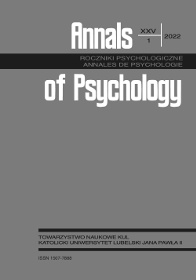Validation of Theoretical and Measurement Model of the Generalized Problematic Internet Use Scale 2 in a Polish Sample
Validation of Theoretical and Measurement Model of the Generalized Problematic Internet Use Scale 2 in a Polish Sample
Author(s): Barbara CiżkowiczSubject(s): Social Sciences, Psychology, Behaviorism
Published by: Towarzystwo Naukowe KUL & Katolicki Uniwersytet Lubelski Jana Pawła II
Keywords: Generalized Problematic Internet Use (GPIU); the cognitive-behavioral model of GPIU; Caplan GPIUS2; measurement invariance
Summary/Abstract: The Generalized Problematic Internet Use Scale (GPIUS2) was developed to operationalize the theoretical cognitive-behavioral model of GPIU. The aims of the study were to examine the theoretical model of GPIU, analyze the psychometric properties of the GPIUS2 among Polish adolescents, study measurement invariance across gender and method of data collection (offline vs. online). The sample comprised of 1,621 participants (52% men, Mage = 20.3). Some participants completed an online version of the GPIUS2 (n = 707, 73% men, M = 17.9), and others filled in a pencil and paper version (n = 914, 35% men, M = 22.1). Reliability was assessed (Cronbach’s α; McDonald’s ω). The factor structure and nomological, convergent, and discriminant validity were tested. The findings of this study supported the reliability and the factor structure of the GPIUS2. The factor similarity in Polish sample and the original US sample was high (Tucker’s congruence coefficients were range: .99–1.00). The structural relationships between the constructs of the model, convergent and discriminant validity were confirmed. The strong measurement invariance of the model across gender and method of data collection was confirmed. The Polish version of the GPIUS2 is a reliable and valid instrument that can be used for Polish adolescent samples. The scale showed measurement invariance across gender and method of data collection. Furthermore, the results support the cognitive-behavioral model of problematic Internet use in adolescents.
Journal: Roczniki Psychologiczne
- Issue Year: 25/2022
- Issue No: 1
- Page Range: 67-85
- Page Count: 19
- Language: English

